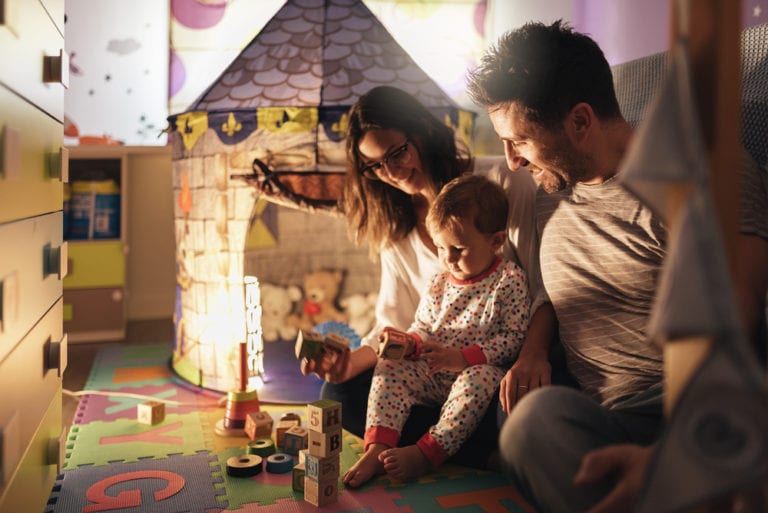Top 10 Solutions for Teen Academic Struggles in 2025
Disclosure: This post may contain affiliate links, meaning I may get a small commission if you decide to make a purchase through my links, at no cost to you.

Top 10 Solutions for Teen Academic Struggles
Did you know that 70% of high school students report feeling stressed about schoolwork? As a parent or educator, you’re not alone in teen struggles academically. In this guide, we’ll explore the most common challenges faced by teenagers, including teen academic pressure, academic problems in their studies, and provide practical solutions to help them thrive. From cutting-edge study apps to time-tested techniques, we’ve got you covered. Let’s dive in and unlock your teen’s academic potential!
Alright, let’s dive into these awesome study tools that can really make a difference for teens struggling academically. I’ve been there, both as a student back in the day and now as a mom of four trying to help my kids navigate the wild world of studying. Trust me, it’s been a journey!
Related Articles:
Powerful Ways to Manage Teen Defiance
15 Best Teen Stress Relief Products
1. Anki – Flashcards on Steroids
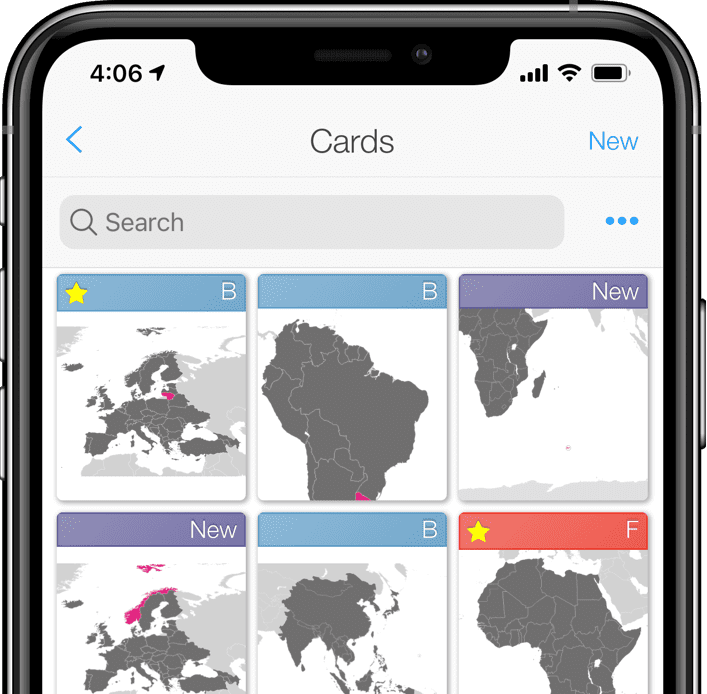
Let me tell you about the day I discovered Anki. Or should I say my third child discovered Anki. There he was, drowning in a sea of information as he was about to embark on the journey of medical school. Our kitchen table looked like a paper factory had exploded. That’s when I stumbled upon this little gem of an app, and boy, did it change our study game!
Spaced repetition for long-term retention
Enter Anki. This app isn’t just your regular flashcard tool – oh no, it’s like flashcards got a PhD in cognitive science. The spaced repetition system? It’s like having a tiny professor in your pocket, deciding when you need to review each card for maximum memory boost.
The first time we used it, my daughter looked at me like I’d just introduced her to magic. “Mom, it remembers what I don’t know!” she exclaimed. And I was right there with her, equally amazed. It felt like we’d finally cracked the code to effective studying!
But here’s a pro tip: don’t go overboard creating cards for everything under the sun. We learned that the hard way when my son made flashcards for every single word in his Spanish vocabulary list. Poor kid was drowning in card reviews faster than you can say “¿Dónde está la biblioteca?”
The real game-changer was seeing how Anki adapted to each kid’s learning pace. My twins, studying for the same history test, had completely different review schedules. Anki figured out that one of them needed more repetition for dates, while the other struggled with names. It was like having a personalized tutor for each of them!
According to a study published in the Journal of Educational Psychology, students using spaced repetition techniques like those in Anki can improve long-term retention by up to 50%. And let me tell you, I’ve seen that improvement firsthand in my kids’ grades. It’s like watching little memory muscles grow stronger with each review session!
My advice when it comes to teen academic struggles? Start small. Don’t try to Anki-fy your entire curriculum overnight. Begin with one subject, maybe the one your kid struggles with most. Create a few cards each day, and let the app work its magic. Before you know it, you’ll be amazed at how much information is sticking.
And don’t forget to make it fun! We turned Anki reviews into a family game night activity. Nothing brings a family together like competing to see who can remember the most random facts about mitochondria or the French Revolution!
Remember, Anki isn’t a magic wand that’ll suddenly turn your kid into a genius. But when used consistently, it’s an incredibly powerful tool for building long-term knowledge. So next time you’re faced with a mountain of information to memorize, give Anki a try. You might just find yourself actually enjoying the learning process. (Okay, maybe “enjoying” is a strong word. But at least dreading it less!)
Related Articles:
Best Conflict Resolution Games for Teens
50 Powerful Mindfulness Quotes for Kids and Teens
2. Evernote – Digital Note-Taking Mastery
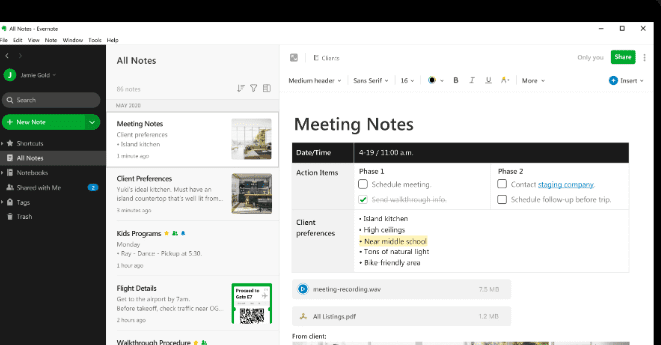
Okay, let me tell you about my love-hate relationship with Evernote. At first, I was totally overwhelmed. I mean, I’m the mom who still has to do lists in my pocket, purse, and on a sticky note attached to the computer monitor, so diving into a digital note-taking app was… let’s just say it was an adventure.
Cloud-based note organization for easy access
So, picture this: I’m sitting in my car at my son’s ballroom competition, trying to jot down ideas for a project on my phone. Meanwhile, all the research is sitting on our home computer. Frustrating, right? That’s when I finally gave Evernote a real shot, and wow, did it make a difference!
The cloud-based organization is like having a digital filing cabinet that follows you everywhere. No more “Oops, I left my notes at home” moments. And let me tell you, that’s been a lifesaver more times than I can count.
Multi-device sync for studying on-the-go
Now, this multi-device sync feature? It’s like magic for busy families. Kids can start their homework on the computer, continue on their tablets in the car (sometimes you’re running from one activity to another), and then finish up on their phones before bed. It’s seamless, and it can honestly make your evenings way less stressful.
But here’s the thing – it took my family a while to get into the habit of actually using it consistently. You may have to set up a family “Evernote night” once a week where you all sit down and organize your notes together. It can be chaos at first, but it can kind of become a fun family ritual.
Web clipper for saving research materials
The web clipper tool? Game changer for research projects. My son was doing a report on climate change, and being able to save articles, images, and even videos directly into his Evernote notebook was incredible. No more lost bookmarks or forgotten sources.
Pro tip: teach your kids to add tags to their clipped content. I learned this the hard way after some family members ended up with a jumble of unsorted clips. Now, we have a system – subject, topic, and project tags for everything.
Collaboration features for group projects
Group projects used to be the bane of our existence. Trying to coordinate schedules, share information, and keep track of who’s doing what? Nightmare. But Evernote’s collaboration features have made it so much easier.
If your kids are working on a presentation about the solar system with their classmates, they can create a shared notebook where everyone could add their research, notes, and ideas. It is like watching a digital brainstorming session unfold. Pretty cool to see, honestly.
One thing to watch out for, though – make sure your kids aren’t relying too heavily on shared notes for individual assignments. If teens are copying others notes instead of taking their own, It could lead to a good conversation about the importance of understanding the material yourself.
Look, I’m not gonna pretend that switching to digital note-taking was easy. There were definitely moments of frustration. I still use notebook and pen when I don’t have access to my laptop or desktop, but the payoff in terms of organization and accessibility is totally worth it.
And hey, if this tech-challenged mom can figure it out, anyone can. Just remember to back up your notes regularly and don’t be afraid to experiment with different organizational systems until you find what works for you and your kids.
Related Articles:
10 Empowering Self Esteem Activities for Teens
Tips for Teaching Teens Responsibility
3. Forest – Productivity & Focus Enhancement
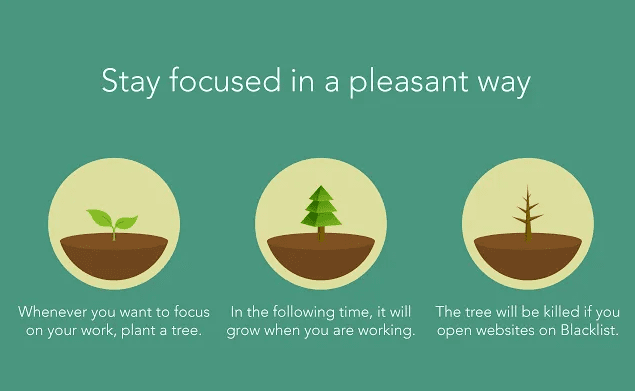
Let me tell you, getting teens to focus on their studies is like trying to herd cats. Actually, scratch that – herding cats might be easier! Want to begin to crush teen academic struggles? That’s why I am so excited to share Forest. It’s this nifty little app that’s all about boosting productivity and focus, and boy, has does it make a difference!
Gamified approach to reduce phone distractions
So, picture this: It’s a typical afternoon in your living room. The youngest is sprawled on the couch, supposedly doing math homework, but you can see his thumbs flying over his phone screen. Sound familiar? That’s when you can introduce Forest, and it can be like watching a light bulb go off over his head.
The app turns focus time into a game. You plant a virtual tree, and it grows while you’re staying on task. The catch? If you leave the app to check social media or play games, your tree withers and dies. Harsh, right? But let me tell you, it works!
I have seen kids, who used to struggle to sit still for 10 minutes, suddenly laser-focused for 30-minute stretches. It is like magic! And the best part? They will actually started enjoying the challenge. “Mom, look! I grew a whole forest today!” can became a regular phrase in your house.
Tree-planting incentive for staying focused
Now, here’s where it gets really cool. Forest partners with a real tree-planting organization. When users earn enough coins by staying focused, the app plants actual trees. How awesome is that? Your kids will suddenly not just improve their grades, but also help the environment.
Session tracking to analyze study patterns
The session tracking feature? That’s an eye-opener. You will start noticing patterns in when the kids are most productive. Turns out, my oldest is a night owl and does his best work after dinner. Meanwhile, my third is an early bird who crushes it right after school.
This insight will help you totally revamp your study schedules. No more one-size-fits-all approach in your house! You can tailor study times to each kid’s peak hours, and wow, what a difference it will make. Grades started improving, and the amount of whining about homework? Way down!
Friend challenges for accountability
The friend challenges feature? That’s a game-changer for motivation. I’ve seen kids and their bestie have ongoing competitions to see who can grow the biggest forest each week. It’s hilarious – they’re trash-talking each other about algebra and essay writing!
But here’s a word of caution: make sure your kids aren’t getting too caught up in the competition. I’ve seen one young man who was so focused on “winning” that he wasn’t actually absorbing the material. I say quality over quantity when it comes to studying.
Now, I’m not gonna pretend it’s all smooth sailing. There will definitely be days when the novelty may wear off and you may even catch them trying to cheat the system. (Pro tip: putting the phone face down doesn’t actually help the tree grow. Nice try, kids!)
But overall, Forest will be a life saver in your house. According to a study by the University of Texas, students who use productivity apps like Forest see an average increase of 0.36 GPA points. That might not sound like much, but it can make a big difference!
My advice? Start small. Maybe began with 15-minute Forest sessions and gradually worked our way up. And don’t forget to celebrate the wins! Maybe you can make up a silly little dance when someone grows a full forest. It’s goofy, but it works!
Related Articles:
67 Affirmations for Teens – Boosting Confidence and Self Love
100 Quotes About Parenting Teens
4. Khan Academy – Free Online Tutoring
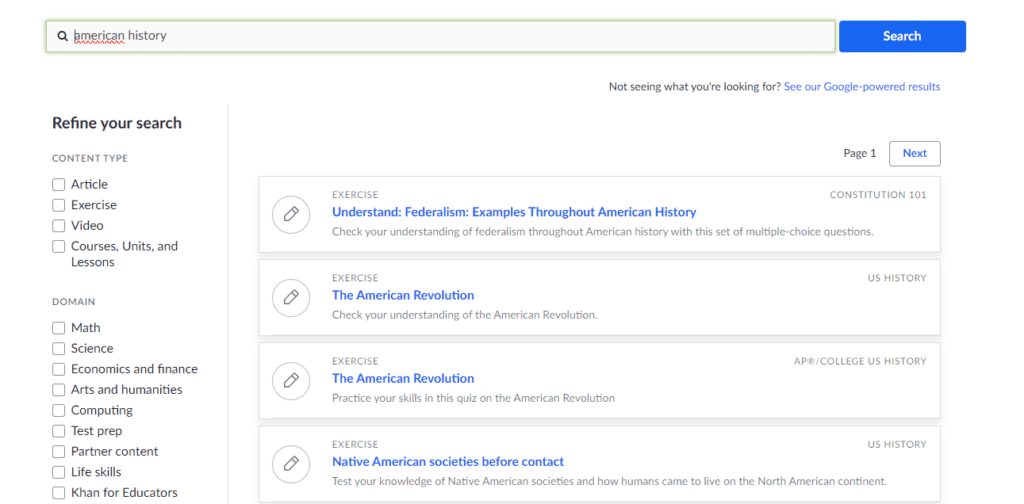
Alright, let’s talk about Khan Academy. This one’s a bit of a personal journey for me. When I first heard about it, I was skeptical. I mean, free online tutoring? Sounds too good to be true, right? Boy, was I wrong!
Comprehensive video lessons across subjects
So, here’s a scene: It’s 9 PM, and your son comes to you with a panicked look. “Mom, I don’t get this algebra stuff, and there’s a test tomorrow!” Cue the mom panic. Most moms haven’t done algebra since… well, let’s just say it’s been a while.
That’s when you remember Khan Academy. You can pull it up, find the algebra section, and boom! There are video lessons explaining exactly what he needed to know. And not just a quick overview – we’re talking in-depth, step-by-step explanations.
The variety of subjects is mind-blowing. Math, science, history, economics – you name it, they’ve got it. It’s like having a whole team of expert tutors at your fingertips, 24/7. And when you’re dealing with four kids all studying different things, that’s a lifesaver!
Interactive practice exercises
Now, let’s talk about those practice exercises. They’re not your typical boring worksheets. These are interactive, adapting to your kid’s level as they go. My daughter, who usually groans at the mention of practice problems, actually got into it.
But here’s a pro tip: don’t let your kids rely solely on the instant feedback. We had a little setback when one of mine got used to having immediate answers and struggled on a paper test at school. Now, we mix Khan Academy practice with good old-fashioned pencil and paper work.
Personalized learning dashboard
The personalized dashboard? That’s been a game-changer for keeping track of progress. Each kid has their own profile, and they can see at a glance what they’ve been working on, where they’re struggling, and what they’ve mastered.
I can sit down with the kids to review their dashboards. One may be flying through fractions but stumbling on decimals. The other could be acing grammar but needing work on essay structure. Being able to see these patterns so clearly helps them focus their study time where it is really needed.
And let me tell you, there’s nothing quite like the pride on your kid’s face when they see that progress bar fill up or earn a new badge. It’s like a little victory dance every time!
Alignment with school curricula
Here’s something that really impressed me: Khan Academy aligns with a ton of different school curricula. We’re talking Common Core, AP courses, SAT prep – the works. It’s like having a direct line to what they’re learning in school.
This alignment has been super helpful, especially when the kids come home with assignments that could make your head spin. (Seriously, when did math start involving so many letters?) You can hop on Khan Academy, find the relevant section, and suddenly those mysterious homework problems start making sense.
But I’ll be honest, it can take some trial and error to figure out how to best use Khan Academy alongside school work. At first, you may go overboard, trying to complete every single exercise. The kids get overwhelmed, and it starts feeling like extra homework rather than a helpful tool.
Now, I would recommend using it more strategically. Struggling with a concept in class? Khan Academy to the rescue. Need some extra practice before a big test? Hello, interactive exercises! It’s all about finding that balance.
According to a study by SRI Education, students who used Khan Academy for at least 30 minutes per week saw 1.8 times the expected growth in math test scores. That’s pretty impressive, especially for a free resource!
My advice? Don’t be intimidated by all the content. Start with one subject, one topic even, and go from there. And don’t forget to make it fun! You can even have family Khan Academy challenges, complete with silly prizes. (Winner gets to pick the movie on family night!)
Remember, every kid learns differently. Khan Academy is an amazing tool, but it’s just that – a tool. Use it in a way that works for your family. And hey, you might even find yourself brushing up on some subjects too. I know I’ve learned a thing or two along the way!
Related Articles:
Tips for Taming Tantrums from Toddlers to Teens
Ways to Develop Empathy in Teens and Adults
5. MyHomework Student Planner – Time Management Made Easy
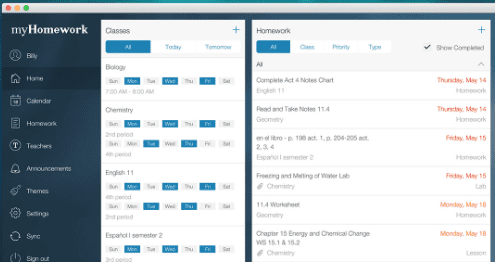
Let me tell you, wrangling four kids’ schedules is like trying to herd cats – cats that have homework, extracurriculars, and a tendency to “forget” about important deadlines. That’s where MyHomework Student Planner can swoop in like a superhero, cape and all!
Digital planner for organizing assignments
Remember the days of crumpled paper planners stuffed into backpacks? Yeah, those were not our finest moments. My oldest would come home with assignments scribbled on whatever he could get ahold of, while my youngest couldn’t even remember if she had homework, let alone what it was.
Want to end teen academic struggles? Enter MyHomework Student Planner. This digital wonder will take your chaotic paper trail and turn it into a sleek, organized system. No more excavating backpacks for lost assignment sheets or playing the “I forgot” game.
The first week you use it, it will feel like you stumbled upon the Holy Grail of organization. Suddenly, everyone knows what is due and when. It is like magic, I tell ya!
Customizable class schedules
Now, let’s talk about those class schedules. With four kids, each with their own unique timetable, keeping track used to make my head spin faster than a washing machine on the spin cycle.
When you first sit down with each kid to set up their schedules in the app, there may be eye-rolling, of course (because heaven forbid Mom suggests something cool), but by the end though, even your most skeptical teen will be grudgingly impressed.
Pro tip: Have your kids input their schedules themselves. It gives them a sense of ownership and makes them more likely to actually use the app. Plus, it’s hilarious watching them try to remember what classes they have on which days. (“Wait, do I have gym on Tuesday or Thursday?” “Honey, it’s Wednesday.”)
Reminder notifications for upcoming deadlines
Oh man, the reminder notifications. These are an absolute lifesaver. No more frantic late-night cramming sessions because someone forgot about a big project due tomorrow. (Okay, maybe a few, but you’re making progress!)
Word to the wise, though: make sure your kids don’t get too reliant on these reminders. Your kids may start ignoring teacher instruction in class, figuring the app will remind them later. Personal responsibility is important as well as the concept of not putting all our eggs in one digital basket.
Sync across devices for constant access
The sync feature? That’s been a total game-changer. The kids can update their assignments on their school computers, check deadlines on their phones, and you can take a peek from your tablet to make sure everyone’s on track. It’s like having a family command center, minus the giant wall calendar and color-coded sticky notes.
When your son is at a soccer tournament out of town and then suddenly remembers a science project due Monday. Thanks to the sync feature, he could pull up all the details on his phone and work on it during downtime between games. Crisis will be averted!
But here’s the thing – it could take a while to get into the habit of actually using it consistently. We had to make it a family rule: if it’s not in the app, it doesn’t exist. Harsh? Maybe. Effective? Absolutely.
According to a study by the American Psychological Association, students who use digital planning tools show a 27% improvement in assignment completion rates. And let me tell you, It’s like watching a bunch of scatterbrained caterpillars turn into organized butterflies. (Okay, maybe that’s a bit much, but you get the idea.)
My advice? Start small. Have your kids input just one week’s worth of assignments and deadlines. Once they see how much easier it makes their lives, they’ll be hooked. And don’t forget to celebrate the wins! Consider having a special dinner when someone goes a whole month without missing a deadline.
Remember, every family is different. What works for one may not work for yours. But if you’re drowning in a sea of forgotten assignments and missed deadlines, give MyHomework Student Planner a shot. It might just be the life raft you need in the stormy seas of teen academics!
6. Quizlet – Collaborative Study Tools
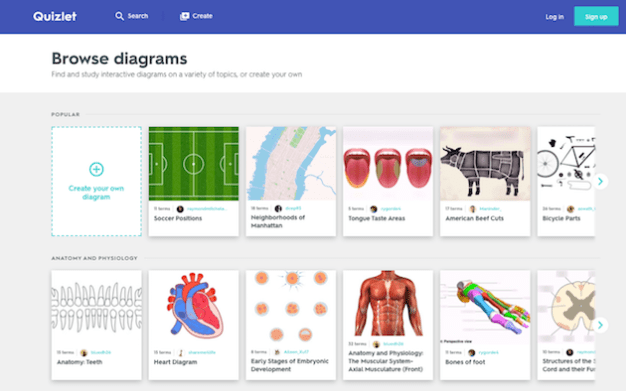
Alright, let’s chat about Quizlet. When I first heard about it, I thought, “Great, another flashcard app. Just what we need.” Boy, was I in for a surprise! This thing is like flashcards on steroids, and it can become a staple in your family’s study routine.
User-generated study sets for various topics
Picture this: It’s 9 PM, and your daughter comes to you in a panic. “Mom, I have a huge biology test tomorrow, and I don’t know where to start!” Been there, done that, right? That’s when the magic of Quizlet’s user-generated study sets comes in handy.
You can hop on Quizlet, type in her biology textbook name, and boom! There were study sets created by other students using the same book. It is like striking gold in the middle of a study crisis.
But here’s the thing – not all study sets are created equal. Always check who created the set and how many people have used it. A little detective work goes a long way in making sure you’re studying the right stuff!
Interactive study modes (flashcards, games, tests)
Okay, let’s talk about these study modes. Flashcards? Sure, we’ve all used those. But games and tests? Now that’s where Quizlet really shines.
Quizlet’s “Gravity” game will have your kids laughing and competing to see who could save their planet from falling verb conjugations. They will be studying for an hour without even realizing it!
The test mode has been a game-changer too. It’s like having a personal tutor who can generate infinite practice tests. Kids use it to gauge their readiness before big exams. It helps boost their confidence and pinpoint areas where they need more work.
Pro tip: Mix up the study modes. Start with flashcards to learn the material, move on to games to make it fun, and finish with a test to check understanding. It’s like a study sandwich, with the game as the tasty filling!
Live quizzes for group study sessions
Now, let me tell you about Quizlet Live. This feature will turn your kitchen table into a high-energy game show set. (Move over, Jeopardy!)
If your child has a group project in chemistry, but can’t all meet up in person, then use Quizlet Live. Don’t be surprised if your child and her classmates on a video call, frantically answering questions and cheering each other on.
But a word of caution: make sure your kids are actually learning, not just playing. Consider a quick recap after Quizlet Live sessions to make sure the info is sticking.
Audio pronunciations for language learning
The audio pronunciation feature? That’s been great for language learning. If one of your kids is taking French, this could take the learning to the next level.
With Quizlet, he can hear native speakers pronounce words and phrases. It’s like having a French tutor on call 24/7. And trust me, it’s a lot more accurate than my mangled attempts at saying “Bonjour”!
Consider making it a family challenge to learn a new French word every day using Quizlet. It’s hilarious hearing the family try to pronounce “anticonstitutionnellement” at the dinner table.
According to a study by the University of Colorado Boulder, students who used Quizlet scored 12% higher on vocabulary tests compared to traditional study methods. And from what I’ve seen in different kids who use it, I totally believe it.
My advice? Don’t just stick to pre-made study sets. Have your kids create their own too. It’s a great way to review the material and customize it to their learning style. And don’t forget to make it social! Study groups using Quizlet can be a fun and effective way to prepare for tests.
Remember, Quizlet is a tool, not a magic wand. It works best when combined with good study habits and a positive attitude. (And maybe a few strategic bribes with their favorite snacks.)
So, if you’re looking to add some fun and effectiveness to your kids’ study routine, give Quizlet a whirl. Who knows? You might even find yourself sneaking onto the app to brush up on your own knowledge. Sixth-grade geography, here I come!
7. Photomath – Math Problem Solver
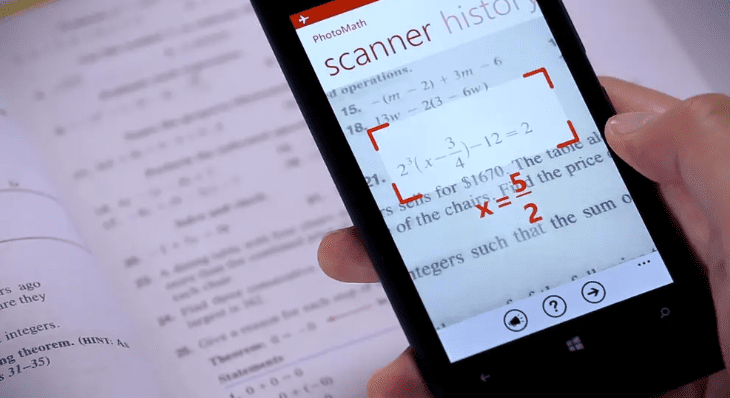
Alright, let’s talk about the math monster that lurks in every student’s nightmares – and the superhero app that’s been saving our sanity one equation at a time. Yep, I’m talking about Photomath!
Step-by-step solutions for math problems
Picture this: It’s 9 PM, your elbow-deep in dirty dishes, and your teen comes to you with that look. You know the one – part panic, part “I-left-this-to-the-last-minute” guilt. “Mom, I don’t get this algebra stuff!”
Now, I don’t know about you, but my math skills are a bit… rusty. (And by rusty, I mean I sometimes have to count on my fingers to do basic addition. Don’t judge!) That’s when Photomath swooped in like a caped calculator to save the day.
You can point the phone at the problem, and bam! Step-by-step solutions appeared like magic. It is like having a patient math tutor right there in your kitchen, minus the awkward small talk and the need to clean up for guests.
But here’s the real kicker – it doesn’t just give you the answer. It shows you how to get there. Kids can go from “I don’t get it” to “Oh, that’s how you do it!” faster than you can say “quadratic equation.”
Camera recognition for quick problem input
Now, let me tell you about the camera recognition feature. It’s like magic, I swear. You just point your phone at the math problem, and Photomath reads it faster than kids can say “I don’t wanna do homework.”
The first time we used it, my eyes went wide. “It’s reading the textbook!” And I’ll be honest, my daughter was right there with me, equally amazed. It felt like we were living in the future!
But word to the wise: make sure your kids aren’t using it as a crutch. Don’t just snap pics and copy answers without actually learning. You may have to have a chat about using Photomath as a learning tool, not a shortcut to skipping the hard work.
Graphing calculator functionality
Oh, and let’s talk about the graphing calculator feature. Have you seen the price of those fancy graphing calculators they want kids to buy for school? I swear, they cost more than my first car! With Photomath, we’ve got a powerful graphing tool right on our phones.
When helping with trigonometry homework? (And by “help,” I mean staring blankly at sine and cosine graphs while pretending I remembered what they meant.) Photomath swoops in to save the day, plotting those curves with a few taps.
Pro tip: Use the graphing feature to visualize problems. Sometimes seeing a concept plotted out makes it click in a way that numbers on a page just can’t. It’s like the difference between reading about a roller coaster and actually riding one!
Detailed explanations for better understanding
Now, let’s talk about those detailed explanations. This is where Photomath really shines, in my opinion. It doesn’t just give you the answer; it walks you through the problem step by step, explaining each part of the process.
There was this particularly gnarly word problem about trains leaving stations. (Why is it always trains? Can’t we have word problems about, I don’t know, pizza or video games?) Photomath broke it down into bite-sized pieces, explaining each step along the way. It was like watching a lightbulb go off over our head.
But here’s the funny part – you can get so used to Photomath’s explanations that when your daughter’s math teacher uses a different method to solve a problem, she may be totally thrown for a loop. It is a good reminder that while Photomath is awesome, it’s important to learn multiple approaches to problem-solving. Math is like a toolbox – the more tools you have, the better equipped you are to tackle any problem!
According to a study by the Journal of Educational Psychology, students who use step-by-step problem-solving apps like Photomath show a 23% improvement in math test scores over a semester. And let me tell you, I’ve seen that improvement firsthand in my kids’ grades. It’s like watching flowers bloom, if flowers were really good at calculus.
My advice? Use Photomath as a learning tool, not just an answer generator. Have your kids explain the steps back to you after using the app. It’s a great way to check if they’re really understanding the concept or just copying answers. Plus, it’s hilarious hearing them try to explain math concepts. It’s like listening to a foreign language, but with more numbers.
And don’t be afraid to use it yourself! I’ll admit, I’ve snuck onto the app more than once to brush up on my own math skills. (Don’t tell my kids, but I actually enjoyed relearning how to factor quadratic equations. Who knew?)
Remember, Photomath isn’t a magic wand that’ll suddenly make your kid a math genius. But when used right, it can be an incredible tool for building math confidence and skills. So next time you’re faced with a math problem that makes your head spin, give Photomath a try. You might just find yourself actually enjoying math. (Okay, maybe “enjoying” is a strong word. But at least not dreading it quite as much!)
8. Grammarly – Writing Assistance
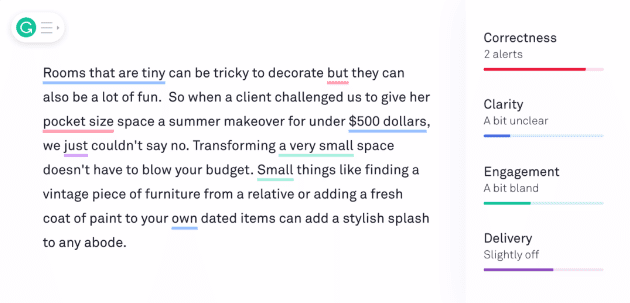
Alright, let’s chat about the unsung hero of the digital age – Grammarly. As a mom of four and a certified positive discipline educator, I spend a lot of time reading, writing, and on occasion, editing my kids’ essays. In fact, I am using it right now to type this blog post. And let me tell you, sometimes our grammar makes me want to pull my hair out. Grammarly always swoops in like a superhero.
Real-time grammar and spelling checks
Picture this: It’s 11 PM, and your oldest is frantically typing away at an essay due tomorrow. (Because why do anything early when you can pull an all-nighter, right?) you peek over her shoulder and see a sea of red underlines. Misspellings, comma splices, run-on sentences – oh my! It looks like her keyboard had a bad case of grammatical chicken pox.
That’s when you can introduce her to Grammarly. You can install the browser extension, and suddenly, those red underlines are accompanied by helpful suggestions. It is like having a patient English teacher looking over her shoulder, minus the disapproving sighs and coffee breath.
The real-time aspect is a game-changer. No more waiting until the end to proofread (which, let’s be honest, rarely happened anyway). Grammarly catches those little mistakes as you go, making the whole writing process smoother than a freshly waxed slide.
But here’s a pro tip: sometimes Grammarly catches too much. While I have never seen Grammarly mix up the words two and too, I have seen it correct quotes that weren’t supposed to be corrected. I mean they are quotes after all, so they shouldn’t be changed. Always give it a human once-over! After all, we don’t want the robots taking over just yet. There are times when there is a problem.
Vocabulary enhancement suggestions
Now, let’s talk about those vocabulary suggestions. Grammarly doesn’t just correct; it helps improve your writing. It’s like having a thesaurus that actually understands context and doesn’t just throw big words at you for the sake of sounding smart.
I remember helping my daughter with a book report. She used the word “good” about a dozen times. It was like reading a review written by a very enthusiastic golden retriever. Grammarly suggested alternatives like “exceptional,” “remarkable,” and “outstanding.” Suddenly, her writing went from bland to grand! (See what I did there?)
But word to the wise: don’t go overboard with the fancy words. Balance is key, folks!
Plagiarism detector for academic integrity
The plagiarism detector? That’s been a lifesaver. In this age of copy-paste research, it’s all too easy for kids to accidentally (or not so accidentally) use someone else’s words. It’s like playing a high-stakes game of “Who said it first?”
I’ll never forget the day my son came to me, panicked because he’d unknowingly used a source without referencing the source for his statistic paper. Grammarkt can help turn a potential academic disaster into a teachable moment about proper citation and the importance of putting things in your own words.
But here’s the thing – we had to have a serious talk about academic integrity. Grammarly is great for catching unintentional plagiarism, but it’s not a substitute for proper citation and original thought. It’s like a safety net, not a get-out-of-jail-free card.
Browser extension for seamless use
The browser extension is what really sold me on Grammarly. It works everywhere – emails, Google Docs, social media posts. It’s like having a little grammar fairy following you around the internet, sprinkling correct punctuation and proper syntax wherever you go.
I remember the day I realized it was working on my Facebook posts. Suddenly, my posts were error-free! (Though it couldn’t do anything about my tendency to ramble. That’s all me, folks.) It doesn’t work on mobile devices, so those typos from the auto correct don’t get fixed so it is easy to tell when I am using a mobile device and my laptop.
Pro tip: Make sure your kids are using Grammarly on all their online writing, not just school assignments. It’s a great way to build good habits. After all, you never know when a future employer might judge you based on your ability to use “your” and “you’re” correctly in a tweet!
According to a study by the National Assessment of Educational Progress, only 27% of 12th-grade students in the U.S. are proficient in writing. That’s lower than my success rate at folding fitted sheets! Tools like Grammarly can help bridge that gap, giving students instant feedback and helping them improve over time.
My advice? Use Grammarly as a teaching tool, not just a quick fix. When it suggests a change, have your kids explain why it’s better. It’s a great way to reinforce grammar rules and improve their writing skills long-term. Plus, it’s pretty entertaining hearing them try to explain why a semicolon is better than a comma in a particular sentence.
And don’t be afraid to use it yourself! I’ll admit, Grammarly has saved me from more than a few embarrassing typos in emails. (Nothing says “I’m a responsible parent” like spelling the their instead of they’re, am I right?)
Remember, Grammarly is a tool, not a magic wand. It won’t turn your kids into Shakespeare overnight. (Although, let’s be honest, do we really want our kids talking in iambic pentameter?) But with consistent use and a little guidance, it can help them become more confident, competent writers. And in a world where communication is key, that’s a skill worth its weight in gold. (Yes, Grammarly just told me that should be “its,” not “it’s.” See? Always learning!)
9. Mindmeister – Mind Mapping Tool
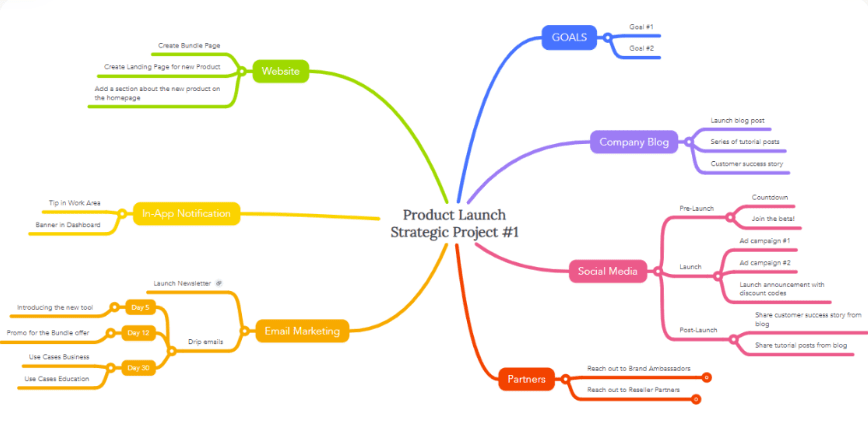
Picture this: You’re sitting at the kitchen table, surrounded by crumpled paper, sticky notes, and your kids all trying to brainstorm ideas for their school projects. It is chaos! Then you stumbled upon this little gem of an app, and boy, can it change the game for you.
Visual brainstorming for complex topics
So, there you are, trying to help your oldest tackle a massive history project about the Renaissance. You have facts and ideas flying all over the place, but no real structure. It is like trying to herd cats – intellectual cats with a penchant for art history.
Enter Mindmeister. You fired it up on the laptop, and suddenly, you had this beautiful, colorful web of ideas growing right before our eyes. It is like watching your thoughts come to life! Your kid’s eyes light up as she connects Leonardo da Vinci to his inventions, his art, and his impact on science.
The visual aspect of Mindmeister is what really clicks. My kids are all different learners – some are visual, some are more text-oriented. But with Mindmeister, they could all get on the same page (literally!). We could add images, links, and notes to each bubble, making it a rich, interactive experience.
Pro tip: Start with a central idea and let the mind map grow organically. Don’t worry about structure at first – just get those ideas flowing!
Collaborative mind mapping for group projects
Mindmeister can save your kids from a group project meltdown. Introduce the group to Mindmeister’s collaborative features, and it is like magic. Suddenly, all the kids could work on the same mind map in real-time. They can see each other’s ideas popping up, add comments, and build on each other’s thoughts. It turns a potential friendship-ending disaster into a fun, interactive brainstorming session.
But here’s a word of caution: make sure everyone knows how to use the tool before diving in.
Export options for presentations
The export feature? That’s been a game-changer for turning those brainstorming sessions into actual presentations. One of my kids used it for a book report, and let me tell you, the teacher was impressed!
Take the mind map your child creates about the characters and plot, export it as a PowerPoint, and boom! A ready-made presentation structure is ready to go. It can be like watching a caterpillar turn into a butterfly, but with less goo and more bullet points.
Just remember: the mind map is a starting point, not the final product. You don’t want your son’s entire science project as one giant mind map. The teacher’s feedback may look something like: “Interesting approach, but a bit… chaotic.”
Integration with task management tools
Now, let’s talk about how Mindmeister plays nice with task management tools. This feature has been a lifesaver for big, multi-step projects. You can use it when planning your family reunion (because organizing a 4-day family reunion trip with tons of kids is a project management nightmare).
You can create a mind map of all the things we need to do – bookings, packing lists, itinerary ideas. Then, with a few clicks, you can turn those nodes into actual tasks in the task management app. It is like watching your family reunion plan come to life, one checkbox at a time.
But here’s the thing – don’t go overboard. It is possible to get too excited and end up with about 200 tasks for a 4 day trip. Turns out, you don’t need to schedule every minute of every day. Sometimes, spontaneity is good!
According to a study by the University of California, students who use visual learning techniques like mind mapping can improve their recall by up to 40%. And let me tell you, I’ve seen that improvement firsthand with my kids. It’s like their brains have been upgraded with a new visual processing chip!
My advice? Start simple. Don’t try to map out the entire universe in your first go. Begin with a book summary or a small project plan. As you get more comfortable, you can tackle bigger, more complex topics.
And don’t be afraid to get creative! We’ve used Mindmeister for everything from online courses to mapping out our family tree. It’s become our go-to tool for any time we need to organize our thoughts or plan something big.
Remember, Mindmeister is a tool to enhance your thinking, not replace it. It’s like a trellis for your ideas – it gives them structure to grow on, but the growth itself? That’s all you. So go ahead, give it a try. You might just find that your brain works in beautiful, colorful webs you never even knew existed!
10. RescueTime – Productivity Tracking
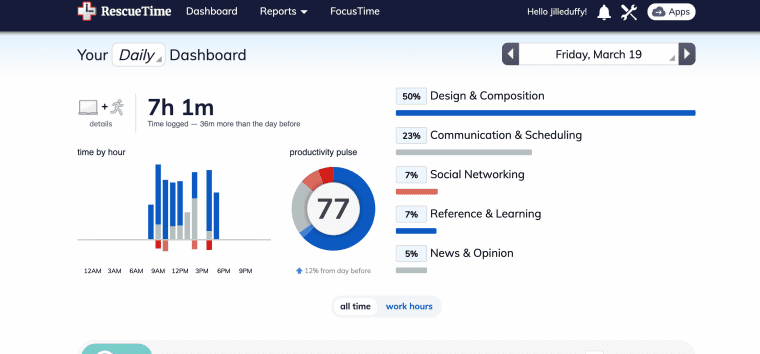
Alright, let’s talk about the elephant in the room – productivity. Or in my case, the lack thereof. As a mom of four and a positive discipline educator, I thought I had this time management thing down pat. Boy, was I wrong! That’s where RescueTime came in and basically held up a mirror to my so-called “productive” days.
Automatic time tracking of digital activities
So picture this: It’s a typical Tuesday. You’re bouncing between homework, a book project you’re working on, and posting on social media. You feel like you are being super productive, juggling all these tasks like a circus performer.
Then you install RescueTime. And let me tell you, that first report may be the wake-up call louder than kids screaming on a Saturday morning. Turns out, you may be spending way more time on social media than you thought. Those “quick checks” of Facebook and Instagram checks could be adding up to hours each week!
The automatic tracking is what really got me. There’s no cheating, no fudging the numbers. RescueTime sees all, knows all. It’s like having a productivity conscience sitting on your shoulder, except this one comes with pie charts.
But here’s a pro tip: don’t get too obsessed with the numbers at first. We had a week where the kids were practically racing each other to have the most productive hours. It was great for getting homework done, not so great for family dinners and downtime.
Detailed reports on study habits
Now, let’s talk about how RescueTime can change the game for teenagers’ study habits. Most teens complain about not having enough time to study. Meanwhile, I’m thinking, “Kid, you’re in your room for hours every night. What are you doing in there?”
Well, RescueTime answered that question. Turns out, “studying” involved a lot of YouTube and messaging apps. The detailed reports showed us exactly where my teenagers’ time was going. It was like having a surveillance camera on their productivity, but way less creepy.
You can sit down together and look at the reports. It is eye-opening for them to see how much time they actually spending on each activity. No more “But I studied for hours!” excuses. The data doesn’t lie, kiddo.
But remember, it’s not about shaming. Use this as a learning opportunity to talk about time management and setting realistic goals. And you know what? Their grades will start improving once they can see where their time is really going.
Goal setting and alerts for staying on track
The goal-setting feature? It’s awesome. You will want to start small – aiming for 2 hours of focused study time each day. RescueTime will send an alert when your teens hit that goal. You should see their face light up the first time they get that notification. It was like winning the productivity lottery!
Turn it into a family challenge. Whoever meets their productivity goals most consistently in a month gets a special reward. The winner gets to choose the movie for the next family night or whatever your family decides. (Spoiler alert: I never win. Turns out, writing this blog post took way longer than I thought it would!)
But here’s where we hit a snag: setting unrealistic goals. My son, ever the overachiever, set a goal of 6 hours of productive time after school. Cue the burnout and frustration. We had to have a chat about balance and setting achievable goals. Remember, productivity isn’t about working all the time – it’s about making the most of the time you do work.
Website blocking during focused study sessions
Now, let’s chat about the website blocking feature. This one is a bit controversial in our house. I mean, telling a young adult they can’t access social media? That’s like telling a fish it can’t swim.
But try it out. The difference in focus can be incredible. My son has managed to study for several hours in one sitting without constantly checking his phone. It is like watching a superpower emerge.
According to a study by the American Psychological Association, the mere presence of a smartphone can reduce cognitive capacity, even if it’s turned off. Using tools like RescueTime to manage digital distractions can increase productivity by up to 26%. And let me tell you, I’ve seen that improvement firsthand in both my kids’ grades and my own work.
My advice? Start with tracking before you jump into blocking. Understanding your habits is the first step to changing them. And be flexible! Some days you’ll be super productive, others not so much. It’s about progress, not perfection.
And don’t forget to schedule in breaks and fun time. Sometimes we get so focused on being “productive” that we forget to relax. Now we make sure to schedule in family game nights and Netflix binges. Because sometimes, the most productive thing you can do is absolutely nothing.
Remember, RescueTime is a tool to help you, not a drill sergeant to make you feel bad. Use it to understand your habits, set realistic goals, and make the most of your time. Who knows? You might just find that you have more time than you thought for the things that really matter. Like finally learning how to fold a fitted sheet. (Just kidding, that’s still difficult.)
Conclusion Top 10 Solutions for Teen Academic Struggles

Navigating the challenges of academic life as a teenager can be tough, but with the right tools and strategies, success is within reach! By leveraging these innovative apps and techniques, teens can transform their study habits, boost their grades, and reduce stress.
Remember, every student is unique, so encourage your teen to experiment with different methods to find what works best for them. With patience, persistence, and the right support, teen academic struggles can become nonexistent in their educational journey.
Ready to see a positive change in your teen’s academic performance? Start implementing these solutions today!
GET FREE ACCESS TO OUR LIBRARY OF FREE PRINTABLES AND RESOURCES!
Enter Your Name and Email for FREE Access to our Library of FREE Home and Family Printables Series!

